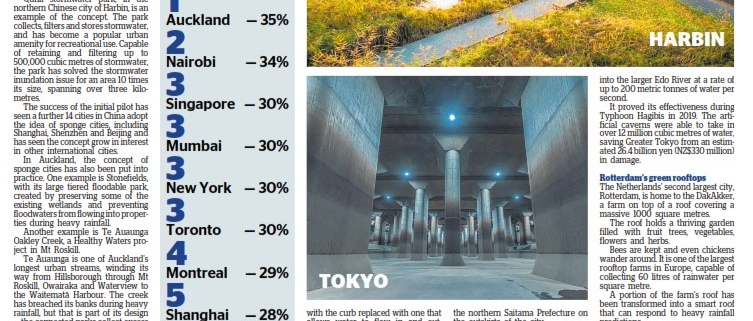Project Auckland: International cities show how to soak up stormwater
Project Auckland: International cities show how to soak up stormwater
In 2015, China implemented a concept known as “sponge cities” in 16 urban areas to combat flooding caused by stormwater.
The initiative was in response to the devastating Beijing flood in 2012, which claimed 79 lives and prompted authorities to make sponge cities a nationwide policy.
The idea was promoted by Chinese landscape architect Yu Kongjian, who advocated for the integration of nature’s ability to absorb, store and filter water into city infrastructure to mitigate against runoff.
This approach involves using green infrastructure to allow water to follow its natural channels, with streams and creeks uncovered, parks and grasslands restored, and planting used to slow down the flow of water and enable natural absorption, infiltration and purification. This is in stark contrast to the conventional grey infrastructure solution that speeds up the flow of water using pipes and drains.
Qunli stormwater park, in the northern Chinese city of Harbin, is an example of the concept. The park collects, filters and stores stormwater, and has become a popular urban amenity for recreational use. Capable of retaining and filtering up to 500,000 cubic metres of stormwater, the park has solved the stormwater inundation issue for an area 10 times its size, spanning over three kilometres.
The success of the initial pilot has seen a further 14 cities in China adopt the idea of sponge cities, including Shanghai, Shenzhen and Beijing, and has seen the concept grow in interest in other international cities.
In Auckland, the concept of sponge cities has also been put into practice. One example is Stonefields, with its large tiered floodable park, created by preserving some of the existing wetlands and preventing floodwaters from flowing into properties during heavy rainfall.
Another example is Te Auaunga Oakley Creek, a Healthy Waters project in Mt Roskill.
Te Auaunga is one of Auckland’s longest urban streams, winding its way from Hillsborough through Mt Roskill, Owairaka and Waterview to the Waitematā Harbour. The creek has breached its banks during heavy rainfall, but that is part of its design — the connected parks collect excess stormwater and slowly release it back into the creek, preventing flooding for nearly 200 homes.
New York’s pocket rain gardens
On a smaller scale, New York City has implemented pocket rain gardens to help manage its stormwater. These tiny gardens help with the natural absorption of rainwater into the ground instead of allowing it to flow into the sewer system. Strategically located, the pocket rain gardens are installed in areas where their impact on the health of the city’s waterways will be most significant.
Thorough soil testing is conducted before installation to ensure the pocket gardens can efficiently absorb stormwater. The area is then excavated to a depth of around five feet (1.5m) and backfilled with stone and soil, with the kerb replaced with one that allows water to flow in and out. Appropriate plants, flowers and trees are then selected and planted in the area.
The benefits go beyond stormwater management. They help to combat the urban heat island effect, clean the air, promote biodiversity and beautify neighbourhoods.
Tokyo’s underground cathedral
Tokyo, a city built on a flood plain and crossed by five river systems and dozens of individual rivers, has taken a unique approach to risk mitigation. In 1992, construction of the Tokyo Metropolitan Area Outer Underground Discharge Channel began in the northern Saitama Prefecture on the outskirts of the city.
Over 14 years, the world’s largest underground floodwater diversion facility was built to counteract the overflowing of city rivers during intense rain and typhoon seasons. The system’s tunnels and chambers run for 6.3km east to west, featuring 18m-high concrete pillars that create a cathedral-like space underground.
Before it was constructed, the water level from rivers used to flood a large area. The facility is activated around seven times a year, and allows Tokyo to divert and store water in the underground channel, and pump it into the larger Edo River at a rate of up to 200 metric tonnes of water per second.
The facility proved its effectiveness during Typhoon Hagibis in 2019. The artificial caverns were able to take in more than 12 million cubic metres of water, saving Greater Tokyo from an estimated 26.4 billion yen ($330 million) in damage.
Rotterdam’s green rooftops
The Netherlands’ second-largest city, Rotterdam, is home to the DakAkker, a farm on top of a roof covering a massive 1000 square metres.
The roof holds a thriving garden filled with fruit trees, vegetables, flowers and herbs. Bees are kept and even chickens wander around. It is one of the largest rooftop farms in Europe, capable of collecting 60 litres of rainwater per square metre.
A portion of the farm’s roof has been transformed into a smart roof that can respond to heavy rainfall predictions.
The system can make extra water storage capacity in advance of a rainfall event by releasing water slowly up to 24 hours ahead of the rain, giving it the capacity to handle heavy downpours more effectively.



